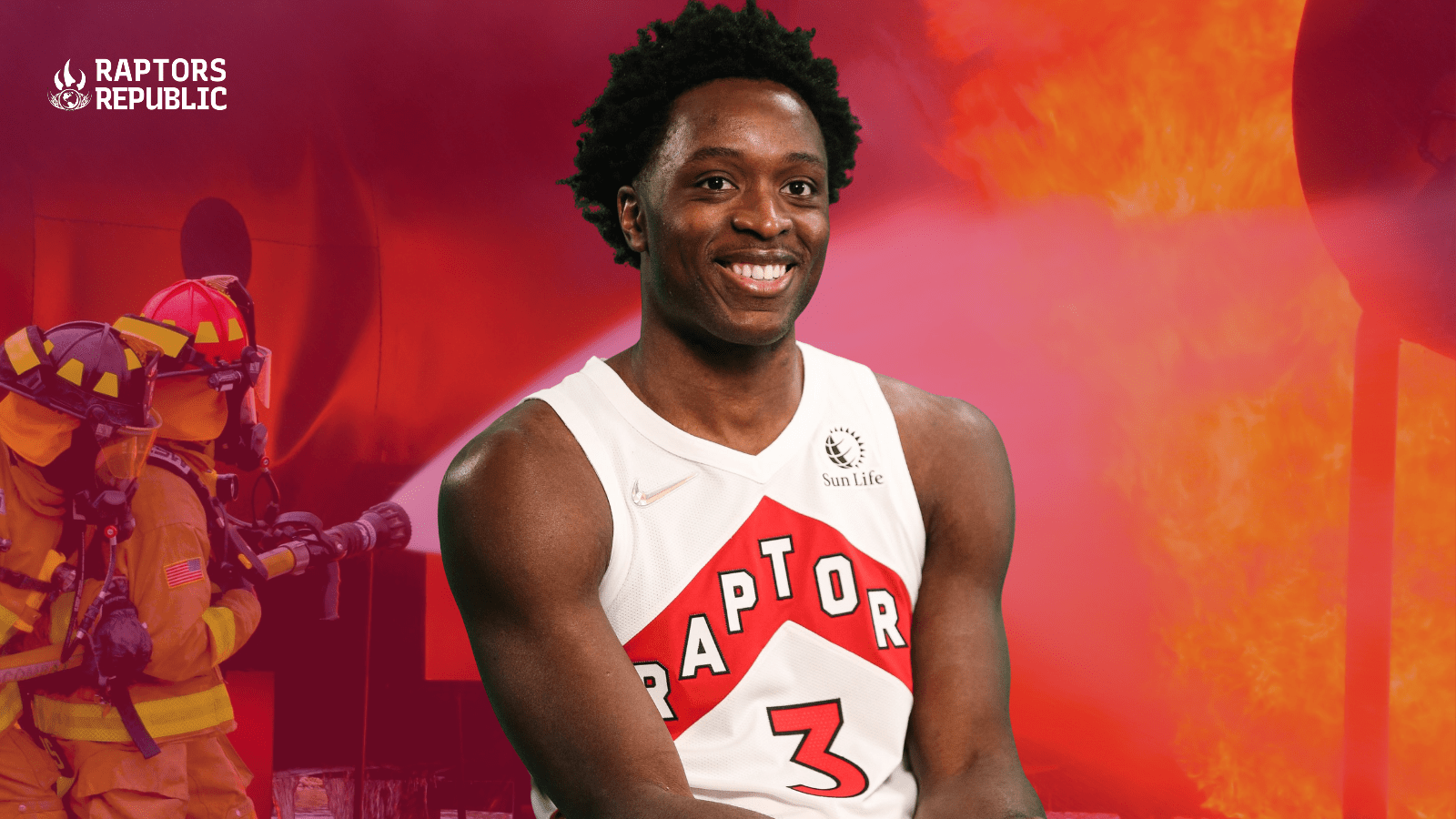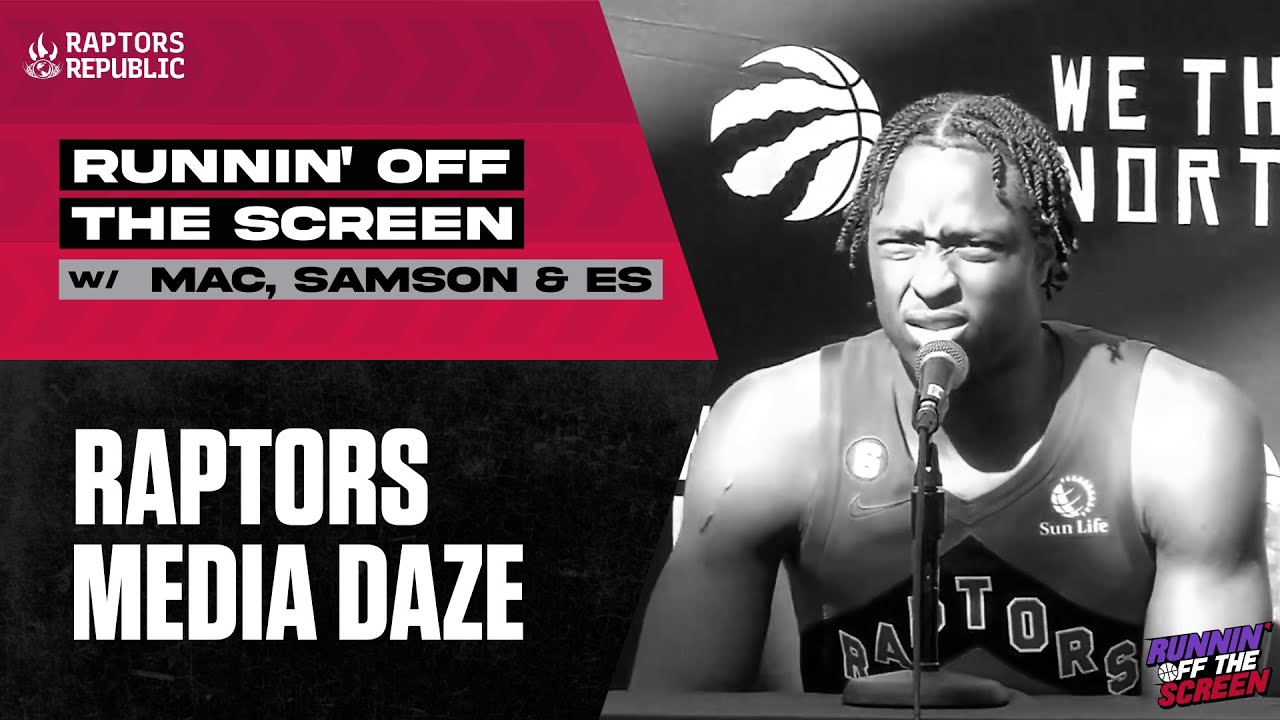One of my favourite Norm MacDonald jokes is the moth joke. It’s a work of art; he turns “why does the moth go into the doctor’s office? Because the light was on” into a five-minute epic that spans the frozen wastelands of Siberia to the modern malaise of the urban man. All this to say: sometimes it’s not such a bad thing to go a little deeper even when brevity is all that’s required.
So will the Toronto Raptors use the same philosophical, on-court schemes in 2022-23? The brief answer is yes. But Norm teaches us that that’s not the worthwhile answer.
Throughout media day on September 26, the buzz words were “improvement” and “winning.” Which, of course. But there were some deeper realizations to be made. And best of all our own Samson Folk opined about the Scottie Barnes of it all.
Beyond the players, though, there’s another haunting question. The Raptors spent much of the last few seasons innovating in a different direction from the rest of the league. As the rest of the NBA moves towards an increasingly homogenized, heliocentric, pick-and-roll attack, the Raptors are moving away from it. Fun, yes, but their shot spectrum has been miserable, with the seventh-worst expected field-goal percentage last year (just below the Orlando Magic). They’ve eschewed triples and been unable to create layups. And this direction has been chosen by one of the most analytically-minded head coaching staffs in the league. So the question: is that going to continue?
I asked Nick Nurse what he learned about his philosophy from last year’s regular season and playoffs.
“I think we learned a lot of lessons,” he said. “Not just me, but I think our players and just our whole organization. I think we created a lot of things defensively that we’ll do again – I think we were number one in the league in deflections…which [is] the main parts of what our system does. What else did we learn? Well, I thought we learned in the playoffs there were a couple things. We had some injuries there, playing without some guys and we said we could be that versatile and we found out, yeah we can. There were chances now where we could really move positions almost in totality.
“And, again, I know there’s the question of ‘how are we going to stop Embiid or the big centers when you don’t have somebody that can bang with them?’ I don’t think it’s that big a problem because I think there are some answers to that within our roster the way it is, and we’ve gotta work with it and come up with ways so there are answers.”
Here’s the too-long-don’t-read: We’ve learned our system works if we lean into it some more. But you’ll note that all of his answers focused on the defensive end. (An even deeper dive on that from me in coming days, by the way.) Indeed, under Nick Nurse, the Raptors have ranked defensively fifth, second, 19th (eww Tampa), and 10th. Consistently very good except for Tampa. (There’s a fascinating story in there about how an offensively innovative coach changed how the league plays defense, but I don’t have the access to write that story. Yet.)
But offensively the Raptors have moved from sixth (with Kawhi Leonard) to 15th, 16th, and 16th, which is much more a tale of subsistence and mediocrity than that of the defensive end. Nurse’s defensive philosophies are provably sound, for the most part. (And again, more on that soon.) But the offensive philosophies should be the ones under question.
Indeed, Nurse faced that very question later in the press conference. Can the core guys get you the kind of shots you want in the half court?
“I think we’re probably heading in that direction,” he said. “I’m not saying we’re full going to leap back to [that] philosophically, on-paper, shot spectrum, but what I do hope is that we hammer the front of the rim. I hope we hammer the free throws getting to the rim. I want to be better at that because that part is like NFL football.
“You’ve got to run it a little bit to open up the pass, and I think getting to the front of the rim opens up the three ball, and we certainly want our share of catch-and-shoot threes. So, I would hope that emphasizing the front end of our shot spectrum would kind of smooth out the overall shot spectrum.”
Nurse there acknowledges that the shot spectrum leaves much to be desired. They aren’t taking many threes or layups or free throws, and those are the three most efficient ways to score. In fact last year, they ranked 22nd in 3-point attempts, 26th in at-rim attempts, and 24th in free throw rate. In that light, it is almost miraculous that Toronto ranked even 16th on offense last season.
Built into those numbers is a lack of talent in individual areas. From this piece: “The Raptors led the league in three players attempting the largest share of the team’s 3-pointers, with 53.6 percent of the team’s total threes coming from the above three.” And from this piece: “Toronto really only had one capable driver all year: Siakam… When he drives to force rotations from the defense and kicks the ball to open teammates, Toronto doesn’t have anyone capable of further attacking the rim from the other side of the court and consistently knifing through the rotating defense to score.” Part of Toronto’s inability to create threes and layups hails from a lack of players on the roster who are successful shooters or drivers.
But on top of those individual struggles, Toronto’s static offensive system further complicates the ugly shot spectrum. Toronto was second in the league in isolations per game last season yet fourth-worst in efficiency when shooting out of isolations. The efficiency may be a talent issue, but the frequency is, at least to some degree, a philosophical choice. Siakam was brilliant initiating out of isolations — less so for himself than as a way to start an offensive sequence for teammates with his pass. Gary Trent jr. was great as a scorer when isolating. Nobody else carried much water there.
So Toronto could opt to change the philosophical system. Nurse could throw out the read-and-react playbook and run 100 pick and rolls a game like the Utah Jazz or Atlanta Hawks. For all his incredible talent, that doesn’t play to Fred VanVleet’s areas of strength. But Siakam could add some pick-and-roll reps, and he even addressed that possibility on media day, saying “just having that opportunity with the basketball makes the game evolve to another level.” He’s in. But a my-turn-your-turn offense based on VanVleet and Siakam running pick and rolls every possession down likely wouldn’t be better than Toronto’s current system.
The Raptors could reinvent backwards by posting up Siakam, Scottie Barnes, and O.G. Anunoby on dramatically more possessions. (For my money, this would help.) But that’s only replacing Toronto’s current area of stasis with another one — it’s not adding extra dynamism to the team’s approach. They would likely create few layups out of the approach, as well. The Raptors could copy the Golden State Warriors and emphasize ball and man movement. But the Raptors don’t have a genius off-ball mover like Steph Curry capable of turning opposing defensive strengths into weaknesses. They would likely create more triples and layups, but turnovers would skyrocket, and winning the possession game is another pillar of the philosophy — one they’d have to sacrifice.
So other options have drawbacks. None are debilitating, and the Raptors are indeed likely to add here and there. I’d imagine they run a handful more pick and rolls for Siakam this year as well as a few more post ups for Anunoby and Barnes. Perhaps VanVleet will, once or twice a game, be able to run a split cut on the strong side of a post up a la Curry. But changes will be incremental, not revolutionary. The Raptors will mostly keep their system intact, meaning viewers should expect to see a large number of static, unhelpful offensive possessions that end in bailout attempts for Siakam. (And he’ll generally do pretty well turning those into points, which is one reason why the Raptors aren’t unhappy keeping the current system in place.)
There are structural reasons to expect the Raptors not to switch up their on-court approach. For one, an incumbent coach will rarely scrap his philosophical approach unless forced, and Nurse is far from being forced to do anything; by and large, Toronto’s trailblazing style is working. Especially defensively, which is Nurse’s calling card. But even on the offensive end, where the Raptors have been average more often than not, Toronto has points in its favour. The shot spectrum is ugly, but the Raptors have dramatically outperformed their expected ranking based on it. The talent is missing key areas of skill.
So, no, Toronto will not drastically alter its philosophical approach to the game. That’s the easy, brief answer. But it turns out when you look deeply, maybe Nurse is correct to keep the same approach, after all.



